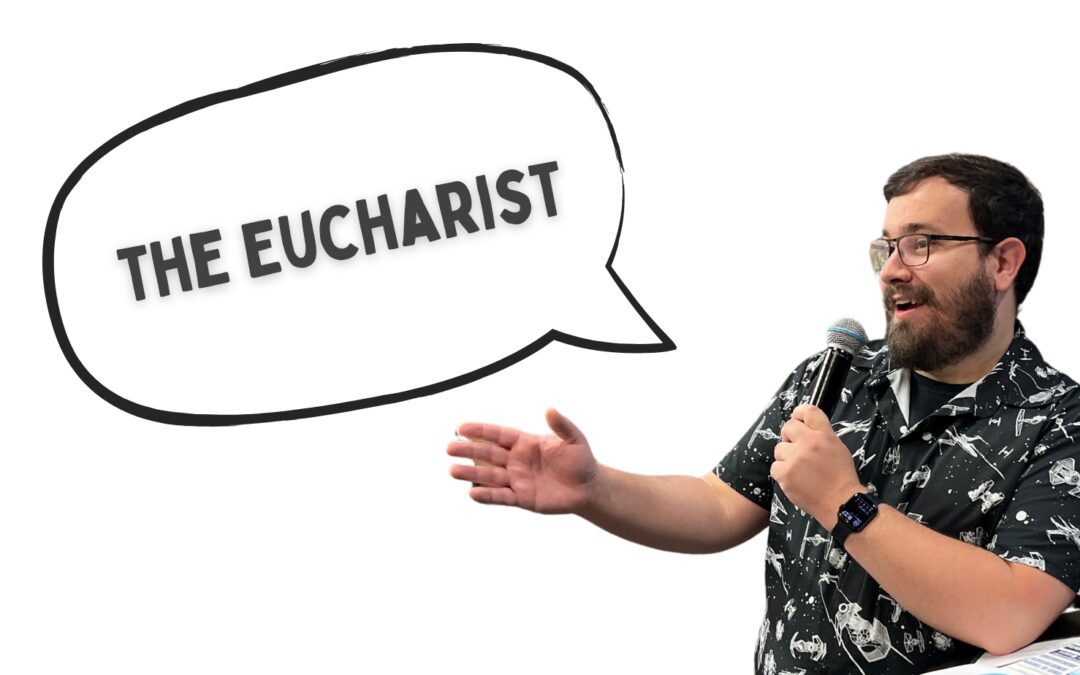“And He took bread, gave thanks and broke it, and gave it to them, saying, ‘This is My body which is given for you; do this in remembrance of Me.’ Likewise He also took the cup after supper, saying, ‘This cup is the new covenant in My blood, which is shed for you.'” ~ Luke 22:19-20
Hello and Welcome to the blog… I’m your host the Pocket Theologian and today we’re discussing the Eucharist, or as it’s known in most of my circles, Communion.
History
So the history of the Eucharist really begins with Christ, since the word Eucharist is taken from the Greek word “Euchariston” which means “giving thanks to God” naturally the two are integrally linked. So like the passage we listened to at the beginning of the blog, says Jesus on the night He was betrayed, when He took the disciples with Him into the upper room, and showed and explain the value of the Eucharistic sacrament. Now from this point on, even in the New Tesamental period, the Eucharist was treated with tantamount importance. With it being considered the sacrament of sacraments; with almost every single church gathering participating or doing it in some form or fashion.
This can be seen in Cyril of Jerusalem’s catechetical lectures. While this elaborated on it a bit more, most theologians followed John of Damascus’ thoughts which were to simply “forward the mystery” which basically means we do it, who cares why? But sooner or later, people start thinking and in the ninth century some people thought about it so much that they knew to disagree with it, and there was a controversy. So the players were Paschasius Radbertus and Ratamnus of Corbie, who were both monks at the monastery of Corbie, both wrote septette works both with the same title called “Concerning the body and blood of Christ” where they developed the classic argument about this topic, known as the “Real Presence” argument; which basically is the idea of the elements literally becoming the body and blood of Christ or whether is was a purely spiritual change not literal.
While this was still happening ANOTHER perspective was pointed out by a monk called Candidus in Germany, who said that Jesus said “this is body” which refers to the church and how communion is to act as a bond of unity. While this argument would come to a head during the reformation, before that, during the Medieval period, some critical terminology was developed which I feel the need to mention. So these come from the writings of Augustine and are explained thus:
Sacramentum Tandum (the sign itself):
So this idea basically means that the physical elements have the capacity to create a miracle.
Res et Sacramentum (the effect brought about by the sacrament):
This is consecration of the elements, imagine God’s presence or Jesus miracle working power infusing and changing the elements into whatever you believe.
Res Tantum (the fruit or aftereffect of the sign):
This is the grace and love of God being extended to the person through the sacrament.
So this all is part of the doctrine that I’ve been tip toeing around for a bit now, and that is the doctrine of Transubstantiation. Which was officially formalized at the Fourth Lateran Council in 1215; which actually used some Aristotelian language for those who are curious.
This topic soon became a major bone of contention when the Protestant Reformation officially broke out, as they believed that adding a philosopher’s thoughts into theology was travesty and should be destroyed as once. Martin Luther himself believed in what is termed Consubstantiation, although he didn’t call it that, which basically was that the body and blood of Christ are created physically inside of the communion elements, meaning that both bread and body and wine and blood are created together. Much like Christ’s dual nature, however other reformers Huldrych Zwingli, being the most prominent, thought that any idea of the elements being transformed was ridiculous.
Now as the Protestant denominations fanned out they all added their own ideas or dimensions to the sacrament, with Catholicism even rethinking its position, as we’ll explain in the notable figures section. With Orthodoxy believing in the “real presence” but choosing not to explain it; Reformed and Presbyterian denominations believing in a spiritual but not physical change in the elements.
Notable Figures
So this section is sort of unique, among our usual blogs, because it is doubling as explanations for the various beliefs in the Eucharist…
Martin Luther:
So like I just explained a little bit ago, Martin Luther believed in what is called Consubstantiation, although once again he DID NOT call it that; that is a theological term developed later. This is the idea that the physical texture of the bread and wine doesn’t fully change into the body and blood of Christ, but rather the body and blood are made inside of the bread and wine, and thus partaking of them acts as a recommitment to Christ. Washing away your sins again.
Edward Schillebeeckx:
Now this one is part of that Catholic theological revival in the 60s, I was talking about earlier. He was a Dutch Catholic theologian, who noticed that the idea of Transubstantiation was becoming more and more doubted among practicing Catholics. Especially after World War 2, so he decided to “reform” the doctrine in a way. What he came up with is called Transfinalization, there are other names for it as well, but that’s the one we’ll use. But, basically this drifts very close to the ideas many Protestants hold, basically this idea is that when you collect the elements and pray the blessing the actual literal and physical structure of the bread and wine do NOT change but rather the end PURPOSE of the bread and wine is changed. Rather than being for the use of sustenance, they take on the purpose of bringing Christians back into fellowship with God.
Huldrych Zwingli:
So Zwingili is pretty well known among Protestant circles, especially for his influence during the Reformation, but in regards to the Eucharist he offers a very unique ideal which is called Memorialism. Which basically means that the sacrament of the Eucharist is a memorial of the suffering of Christ rather than a sacrifice in and of itself. Essentially, when Jesus said “do this in remembrance of me” he meant it exactly as that, a remembrance.
Key Characteristics
Recollection:
One of the major themes of the Eucharist is the idea of looking back, on God’s saving work. This also stresses the continuity between the Old and New Testaments, between Israel and the church. Primarily wrapping Christianity up in a nice package. And when congregations in the modern day all participate in their various ways, it is done in remembrance of Jesus, and what He has done and why He did it.
Anticipation:
The Eucharist also causes men to look forward to the return of Christ. Jesus says in the passage that the Eucharist will be taken again in his kingdom. Now, while you can have a variety of definitions of interpretations of this, one possible interpretation is the idea of Christ’s return and what awaits Christianity when that day comes.
Affirming:
One of the biggest themes of the Eucharist is the affirmation of individual and corporate faith. The Eucharist regardless of how it is performed or seen, is something that only Christians do. When you do it, you participate in a unique exercise among your fellow Christians. It affirms your Christian faith and unites you with other Christians.
Misconceptions
That you can only believe either in literal or spiritual Eucharist:
I believe this is the point that I’ve been building to this whole time! I don’t want to isolate or condemn either side of my Christian brethren. I think like Augustine said in the original controversy it is not the person giving the sacrament, or the elements used, but the God who they are done to, that matters. God understands and I think will receive the wine of my Catholic brothers and the grape juice of my Protestant brothers.
That you can be unworthy of it:
This largely comes from 1 Corinthians 11:27,29. But, here Paul is not speaking of someone unsaved, he is speaking of someone who just eats it like a normal meal; the Eucharist is not a normal meal!
That the Eucharist is to Christ alone:
The Eucharist honors the whole of the trinity, it is done in remembrance of Jesus, the Holy Spirit’s presence enhances the elements, and they are done before the Father… Jesus blood being poured out for all. Amen!
That’s all I have you today… Go in Peace!


Recent Comments